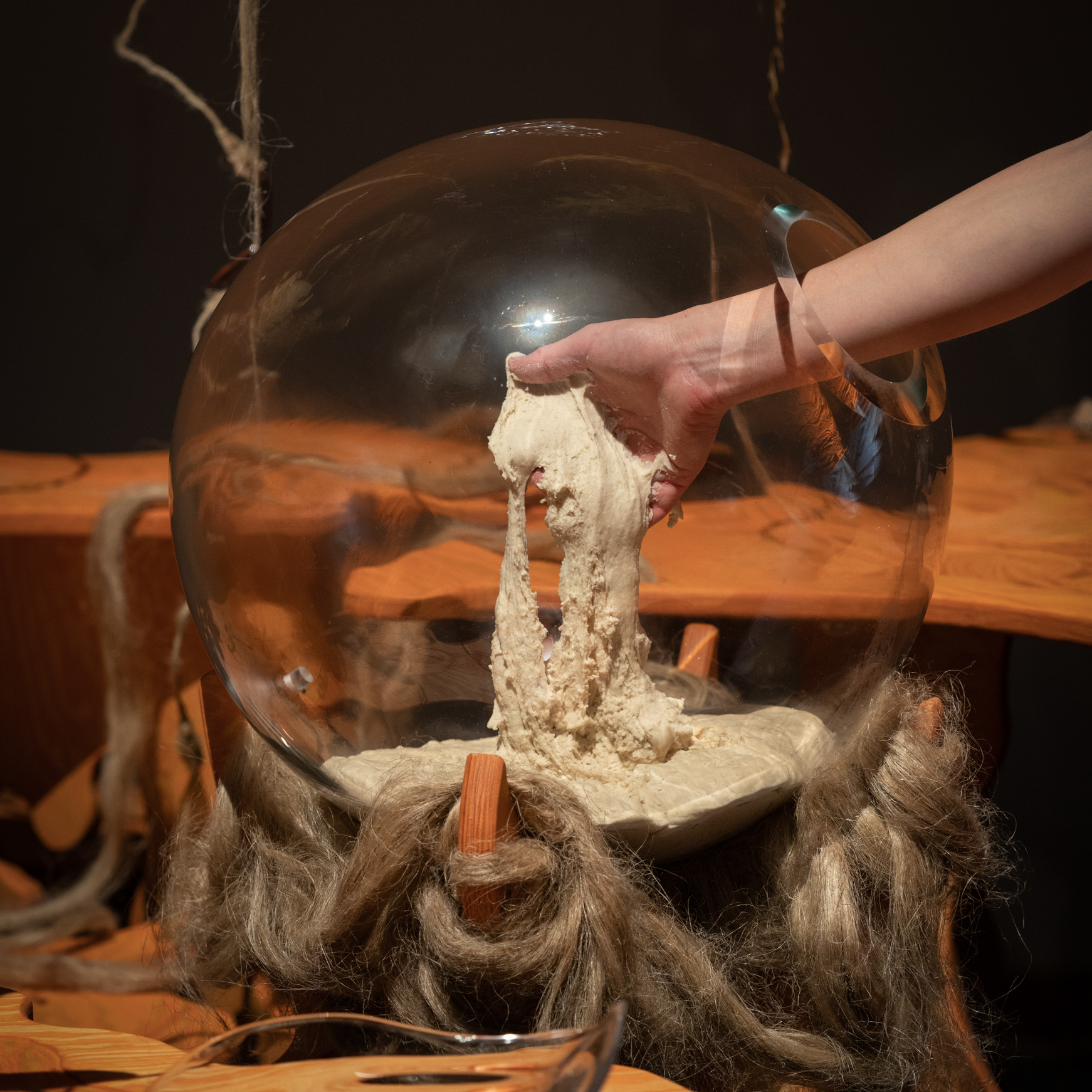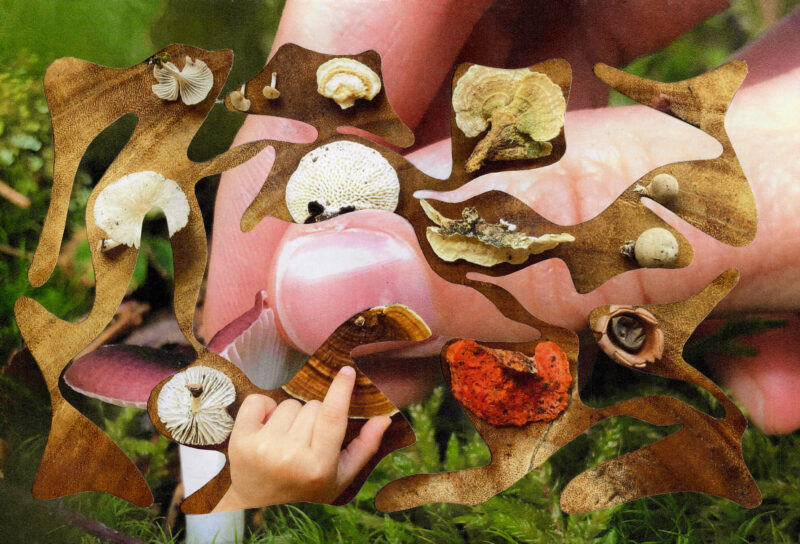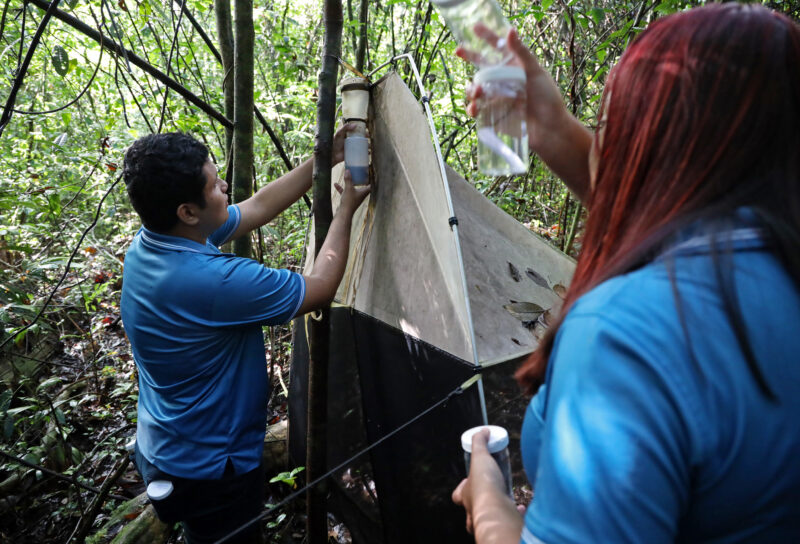DNA does not make RNA and RNA does not make protein. DNA and RNA don’t make anything; they’re part of groups of molecules that must all synchronize for proteins to be synthesized.
It’s no secret that the Central Dogma, that stalwart of molecular biology that “DNA makes RNA makes protein”, is reductive. Its simplicity, however reassuring, doesn’t account for much of what scientists now know about the complexities of genetic function. From our perspective, as social scientists who study synthetic biology, “DNA makes RNA makes protein” isn’t just incomplete or a bit outdated. It’s a tenacious and telling instance of a larger pattern in biology. Relationships—among molecules, cells, creatures—tend to be described in terms of how one controls another. And that pattern matters: to how science happens, and to the futures to which science contributes.
Control language is so ubiquitous across molecular biology and bioengineering that even seeing it can be challenging. It’s conspicuous in high-level statements about goals for engineering biology: achieve more precise control over microorganisms (and maybe other creatures) to exploit them as resources. But it’s also baked into the details of how signal transduction networks are explained as strings of one molecule controlling the behavior of another, how information stored in DNA controls development, how bacteria control biofilm formation… the list is endless. These common phrases quietly embed the notion that biology is an infinite series of command-and-control interactions.
This pattern matters. Modern western cultures have broadly tended to assume that relationships are fundamentally binary and hierarchical: mind and body, action and reaction, man and woman, humans and everything else. Describing biology in those same terms naturalizes situated ideals as universals. The shape of scientific knowledge comes to say that binary, hierarchical relationships are just how biology works—and that it’s therefore only natural that social institutions composed of biological creatures work this way, too. In science studies terms, we call this coproduction: making knowledge is always also making politics. Coproduction works both ways. Imagining biology as fundamentally hierarchical has also made imagining and studying biological complexity, in all its nonlinearity, harder.
Thinking about biology in terms of control is not inevitable, incidental, or neutral. Language is never merely descriptive; everything can be said in more than one way, so language involves choices. Choices reveal values. These values might not be shared by everyone. And recognizing that choices are being made is easier when everyone isn’t making the same choice.
We offer no “right” answers here about how biologists “should” talk about biology to produce good science and good politics. Instead, we want to expand the range of possibilities, so that thinking critically about what biologists—synthetic and otherwise—are producing can be easier. To open space for conversation about the values embedded in biology and the kinds of values scientists, collaborators, and citizens might want to embed in new biologies, we offer three alternatives to control that emerge in our respective research: participation (Erika), interest (Josh), and care (Emma).
Participation
Vinciane Despret, an anthropologist who studies ethologists who study animals, observes that researchers are never just observing their research objects. They inevitably participate in the research and, consciously or otherwise, invite animals to participate with them. Those animals may choose whether and how to participate. Their response tells the researcher about what they—researcher, animal, the experimental apparatus and environment they share—can be capable of together. A scientist conducting communication research with a parrot doesn’t evaluate all parrots’ speech capacities, or this parrot’s capacity in other contexts; she evaluates what this parrot thinks of her efforts to engage it in conversation under the particular circumstances they share. Her results describe how a human might participate in the complex set of factors that collectively shape whether and how a parrot talks. Alex-the-parrot, interacting with cognitive scientists who convince him that his vocalizations can meaningfully influence their responses to him, may make cogent English-language requests related to his desires; a parrot who believes that no one is listening may utter nothing at all.
By the same logic, synthetic biologists test what bacteria and yeast are capable of under particular circumstances. They learn about microbial capacities given particular invitations to participate in an experiment. Their results indicate how scientists can participate in the myriad biotic and abiotic relations that collectively shape microbial behavior. Scaling synthetic biology is challenging because when circumstances change, so do the particular relations that previously enabled success.
Scientists shape microbial living and working conditions, just as their colleagues in other fields might for lab rats in cages or marmots being studied in a zoo. Yet a microbe’s experience of ambient temperature—or of myriad other variables—is likely to reveal micro-environmental variations beyond what a scientist can measure or control. Perfectly controlling every element of a microbe and its conditions, to provide that microbe with only one way to respond, seems unlikely at best.
In Sarah Richardson’s words, microbes “always have a choice.” Microbial responses to scientific interventions aren’t strictly predictable. Cellular behaviors are a function of stochastic mismatches, many molecules bumping into each other—more like a landscape of probabilities than a tidy network, to borrow a metaphor Wallace Marshall has employed in thinking about synthetic biology through cell geometry. Through that metaphor, the goal of engineering biology becomes participating in shaping a landscape that encourages scientist-desirable phenomena to occur. Bioengineers influence events, not control them, by participating in the myriad relations that collectively enact cellular and organismal processes.
If interactions among molecules are described as one molecule acting on another, it’s easy to envision scientists manipulating individual molecules to control cell behaviors. In a landscape of many overlapping, multidirectional interactions, it might be more realistic to think of scientists intervening to participate in those interactions, given that all maps of them are incomplete. Besides, no one is ever the only actor in a network. Well-functioning landscapes make room for more than one organism. Maintaining resilient living network-landscape-organisms that can respond to changing conditions means being part of the network of relations, part of the landscape of probabilities, not a master pulling strings from outside the show—even if mastery of every string was possible.
Well-functioning landscapes make room for more than one organism.
Interest
It first revealed itself to me when working with culinary innovators in Copenhagen. These chefs and fermenters used the word ‘interesting’ to describe what they were pursuing in their flavor-oriented experiments, much more than, say, something being merely ‘delicious’. Things did need to be delicious, of course—yet that was necessary but not sufficient for something to be successful and ready to put on the menu.
As I dug further into this observation, I noticed that this “interesting” did not only mean something novel; it also implied a certain way of relating to their experiments and the microbes that drove them. The most interesting fermentations were at that sweet spot between raw and rotten, which fermenters achieved by involving themselves just enough in the microbial ecology—neither too hands-on nor too hands-off. Attempting total control yielded things that tasted boring and dead; straying too far into a laissez-faire approach yielded things that all tasted a bit samey, the tendency for excessive or sloppy fermentation to converge on similar flavors: boring in a different but equally unacceptable way. Interest here was thus not only an aesthetic judgment—being sensorially remarkable—but also simultaneously an ethical one: that this remarkability, when it arises, is the result of appropriately calibrated human involvement.
If control is so often an all-or-nothing proposition, interest opens up a wider in-between of more or less, this way or that. What matters is not who controls and who is controlled, who shapes and who is shaped—in an interesting, interested world like ours, everything is always both. Control is thus not only inaccurate and simplistic because of its underlying binary, absolute tendencies; it’s also insufficient because, simply put, it’s boring—it doesn’t tell us much about the world or the relations that make it up, and in turn creates boring, simplistic, deadened worlds in its image. To the extent that we’re collectively interested in sustaining liveliness as well as life, what matters instead is tracing who interests whom, who becomes interested in whom, and how different actors—humans, microbes, and otherwise—become involved in each other’s lives and livelihoods as a result.
Contrary to certain popular accounts of science, as philosopher of science Isabelle Stengers observes, scientists are not and cannot be ‘disinterested’. For science to work at all, scientists must be interested: rather than ‘the object’ of objectivity, it is passions, visions, and relationships—in other words, interests—that tie scientists together and make their work possible. E. coli and S. cerevisiae, for example, have been scientifically systematized, then formed into “chassis” and “cell factories,” only thanks to networks of people held together not by the type strains or models or chassis or factories themselves, but by the dream of making them. The scientific object comes after—an achievement that emerges out of interest.
This centrality of interest to science makes me wonder: what might synthetic biology look like if its practitioners started actually harnessing interest as the engine that drives research forward, mostly left out of publications but always there in the daily encounters in the lab, under the hood, at the pipette’s tip? And how might doing so change how we relate to our microbial partners, and thus synthetic biology’s outcomes? Stengers and the Copenhagen fermenters show us one possibility: more conversation than domination; more surprise than boredom; more offerings we probably wouldn’t ever dream up ourselves. The world is more interesting when we’re not the only ones talking. Let’s listen.
Control is thus not only inaccurate and simplistic because of its underlying binary, absolute tendencies; it’s also insufficient because, simply put, it’s boring.
Care
Care is an attribute long prized in science. Being a “careful” scientist, as anthropologist Mike Fortun describes, invokes ideals of scrupulousness in experimental design and data curation. A careful scientist is also a supportive yet critical colleague, promoting rigorous and cautious interpretation of data in the interest of advancing robust knowledge. Presented like this, care is foundational to the authority of science as an enterprise.
But when you dig down, care is more fraught and complex than this description might convey. Care is an inherently relational activity, where someone is caring for something or someone else—caring for data, for laboratory organisms, for one’s students, colleagues, for the scientific enterprise. Far from being a detached, objective practice, care is deeply affective, embodied and subjective. It requires a scientist to invest something of themselves (time, attention, labor) to build and maintain these relationships. It doesn’t always go smoothly: one can care too much, too little, or in the wrong ways, leading to tense or fractured relationships. Framed like this, thinking with care invites us to examine the nature and power dynamics of the relationships being forged through scientific practice.
Care and control have an uneasy relationship. The person caring for often has a great deal of power in structuring the relationships in question. In this sense, they bear significant responsibility for the resulting relationships and outcomes. Who or what they choose to invest in—or conversely, to neglect—is therefore highly consequential. Yet the carer does not ultimately hold all the power. Indeed, giving up some control is critical for building a genuinely reciprocal relationship where each might grow and learn. Parenting offers a clear and relatable example of this: parents are responsible for caring for their children, and have significant power when it comes to shaping the environment and nature of their interactions with their children. But children are active biological agents. They push back, test boundaries and very often rebel if attempts to control become too intrusive. A “good” parent is often seen as one able to step back enough to let their child grow into their own, as having created a relationship strong enough to allow for and even encourage growth through failure.
Striking this balance is hard: the desire to control often comes from a place of care, wanting to promote the best possible future for your offspring (or the clearest outcome for your experiment). But it can backfire, and lead to fractured relationships. In the lab, control-infused values like efficiency might encourage a scientist to base their experiments around evaluation, such as searching for a specific outcome or screening organisms for whether they meet certain criteria (pass/fail, yes/no). Though this paradigm generates results, it creates little room for learning, or for strengthening the connection between researcher and organism. In contrast, experiments grounded in observation may offer more insight about why an organism behaves the way it does, and how to nudge it in a particular direction. Learning and curiosity are central to the practice of care.
Like “interest,” care challenges the all-or-nothing rhetoric of control. Attending to care catalyzes provocative questions about different ways in which control might be sought, and how power and control might best be distributed through a network of meaningful relationships. And crucially, care asks us to grapple actively with the idea of giving up control, or ceding control to others, in pursuit of the world we want to build.
Moving Beyond Control
Control is an entrenched and default mindset in synthetic biology, but we wonder if it’s the only way out of the challenges facing our world today, or if it can even get us there on its own. The three alternatives we’ve suggested here—participation, interest, care—each offer other trajectories for rethinking and remaking relationships among scientists and biological subjects. We’re certain there are others. If biological engineers are striving to build better worlds, their results hinge on envisioning what that “better” looks like and how we might get there. The more strategies we have for relating to our biological subjects, the better equipped we’ll be to build those better worlds.



